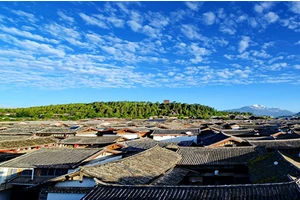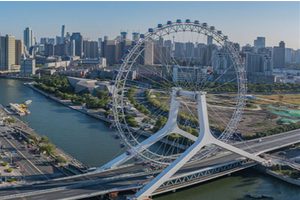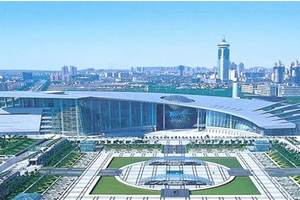Indirect tourism enterprises
[Answer]: Answer: CDE
Analysis: Tourism is a comprehensive industry that serves consumers, creates convenient conditions for the development of their tourism activities and provides needed products and services. Three pillars: travel agency, hotel industry and transportation industry. The five departments are: travel agency department, transportation and passenger transport department, accommodation and reception department, tourist site management department and tourism management organizations at all levels. Direct tourism enterprises: their main income comes from the business of providing services for tourists. Typical representatives are travel agencies, airlines and hotel enterprises. Indirect tourism enterprises: the turnover accounts for a small proportion, such as restaurants, taxi companies, gift shops, entertainment enterprises and urban attractions.
The external environment of an enterprise is a variable factor that is difficult for the enterprise to grasp and control. It is a complex, multi-level and multi-agent three-dimensional structure system. The top management of enterprises can use the information obtained from the external environment to make strategic thinking and decision. Successful companies can constantly evaluate the changes in the industry according to the general trend of the environment, so as to make timely responses to the external environment according to their own conditions.
The external environment of enterprises includes political, economic, social and technical analysis, which is called pest for short.
Political and legal environment: The influence of political environment on enterprises is direct, unpredictable and uncontrollable. These factors often restrict and affect the business behavior of enterprises, especially the long-term investment behavior of enterprises.
Economic environment: The economic environment of an enterprise is mainly composed of four elements: socio-economic structure, economic development level, economic system and macroeconomic policy.
Social natural environment includes social environment and natural environment.
Technical environment analysis is to analyze the existing level, development trend and speed of science and technology related to products of this enterprise, track and master new technologies, new materials, new processes and new equipment, and analyze the impact on product life cycle, production cost and competition pattern.
Evaluation matrix of enterprise external factors
The external factor evaluation matrix (efem) is often used to analyze the external environment of enterprises, which is a common analytical method to analyze and evaluate the key external factors of enterprises. Its procedure is:
(1) List the key factors in the external environment faced by enterprises, including opportunities and threats faced by enterprises.
(2) Give each factor a certain weight (0-1, indicating the degree of importance), and the total weight of all factors is 1.
(3) Score the effective response degree of the enterprise to each factor, with the score range of 1-5. Where 1 is poor, 2 is poor, 3 is average, 4 is good, and 5 is good.
It reflects the serious threat, general threat, no threat and no opportunity, general opportunity or main opportunity of the enterprise.
(4) Weighting and summing all the factors to get a comprehensive score.
Efe competition reflects a subjective judgment, and its evaluation structure may vary with different experts, mainly because the importance of various factors and the indicators of enterprises' effective response to it are relative and dynamic.
SWOT analysis
Swot analysis method, that is, strength, weakness, opportunities and threats analysis, is based on the enterprise's own strength, comparing competitors, and analyzing the opportunities and challenges that may be brought to the enterprise by changes in the external environment of the enterprise, and then formulating the best strategy of the enterprise.
Swot analysis is actually a method to synthesize and summarize all aspects of internal and external conditions of enterprises, and then analyze the advantages and disadvantages, opportunities and threats faced by enterprises. Swot analysis is actually a combination analysis of external environment analysis and internal factors analysis. Therefore, the external environment evaluation matrix and the internal factor evaluation matrix constitute the methodological basis of swot analysis. Among them, the analysis of advantages and disadvantages mainly focuses on the strength of the enterprise itself and its comparison with competitors, while the analysis of opportunities and threats focuses on the changes in the external environment and its possible impact on the enterprise.
1, advantages and disadvantages analysis (sw)
Competitive advantage refers to an enterprise's ability to surpass its competitors and achieve its goals. The main goals of an enterprise include profitability, growth and market share. Therefore, the competitive advantage of an enterprise is not necessarily fully reflected in the higher profit rate. Sometimes, enterprises prefer to maintain the growth rate, increase market share, or stabilize employees.
When analyzing the advantages and disadvantages, we must make a detailed comparison between enterprises and competitors from every link of the whole value chain.
There are three key factors that affect the duration of an enterprise's competitive advantage: ① How long will it take to establish this advantage? ② What are the advantages that can be obtained? ③ How long does it take for competitors to make a strong response? Only by analyzing these three factors clearly can enterprises clearly establish and maintain their competitive advantages.
The advantages and disadvantages of an enterprise can be evaluated by the internal factors of the enterprise, and the internal factors evaluation matrix (ife) can be used to quantitatively analyze the advantages and disadvantages of the enterprise through weighted calculation.
2. Opportunity and threat analysis (0t)
Opportunity and threat analysis mainly focuses on the opportunities and threats brought by the external environment of the enterprise. Development trend of external environment
It can be divided into two categories: one represents environmental threats, and the other represents environmental opportunities.
The unfavorable factors outside the enterprise include: substitution of new products, delay of payment by sellers, alliance of competitors, slow market growth, and enhanced bargaining power of suppliers, which affect the current competitive position of the enterprise.
Environmental opportunities refer to the factors favorable to the development of enterprises in the external environment faced by enterprises, such as policy support, technological progress, good relations with suppliers, bank credit support and so on.
Opportunity and threat analysis can adopt enterprise external evaluation matrix.
3, enterprise strategic choice
According to the analysis of enterprise strengths and weaknesses and opportunities and threats, we can draw a swot analysis chart, and make corresponding strategies for enterprises. As shown in Figure 2-6 of the textbook.
The swot analysis chart is divided into four quadrants, and different strategies should be adopted according to the different positions of enterprises. Swot analysis chart provides four strategic choices. Enterprises in the upper right corner have strong internal advantages and numerous opportunities. Enterprises should adopt the growth strategy of increasing investment, expanding production and increasing production share. Although the enterprises in the lower right corner have great internal advantages, they must face severe external challenges. They should make use of their own advantages to carry out diversified operations, avoid or reduce the impact of external threats, spread risks and seek new development opportunities. The enterprises in the upper left corner are facing external opportunities, but they lack internal conditions, so they should adopt a reversal strategy to change the internal unfavorable conditions. Enterprises in the lower left corner are faced with external threats and problems in their own conditions, so they should adopt defensive strategies to avoid threats and eliminate disadvantages.
Prev: Tourism Huimin month
Next: Fujian Pucheng Tourism






